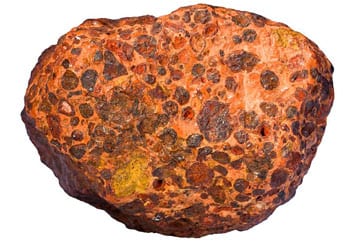Họrọ asụsụ:
Aluminum bụ ihe kasị nkịtị metal mmewere hụrụ na Earth, totaling about 8% nke Ụwa jikọrọ ọnụ. Otú ọ dị, aluminum as an element is reactive and therefore does not occur naturally – it needs to be refined to produce aluminum metal. The isi amalite ihe n'ihi na aluminum ejegharịrị bụ bauxite, ụwa bụ isi azụmahịa isi iyi nke aluminum. Bauxite is a sedimentary rock, and consists mostly of the aluminium minerals gibbsite (Al(OH)3), boehmite (c-Ålö(OH)) na diaspore (a-Ålö(OH)), and is usually mixed with the two iron oxides goethite and hematite, the aluminium clay mineral kaolinite and small amounts of anatase (TiO2) and/or ilmenite (FeTiO3).

Bauxite ego bụ mgbasa zuru ụwa ọnụ, ukwuu n'ime na-ewere ọnọdụ na okpomọkụ ma ọ bụ subtropical na mpaghara. Although proven reserves of bauxite are expected to last for many years, àgwà nke mee na ike ga-aku na uba na-enweta na-adalata. n'ihi refiners, who are in the business of bauxite processing to make alumina, na-emecha aluminum metal, nke a bụ ihe ịma aka na ma ego na gburugburu ebe obibi pụtara.
The process to refine metallurgical bauxite into alumina involves the following inputs:
The following outputs are generated:

The most widely used chemical process of refining bauxite into alumina, usoro Bayer, involves dissolving the Al2O3 out of the bauxite rock with caustic soda (NaOH) at elevated temperature and pressure. The Al2O3 fraction of the bauxite is dissolved into solution, to later be precipitated out as alumina. Otú ọ dị, a high-grade bauxite contains up to 60% Al2O3, and many operating bauxite deposits are well below this, mgbe ụfọdụ dị ka ala dị 30-40% Al2O3. Because the desired product is a high purity Al2O3, ndị fọdụrụ oxides na bauxite (Fe2O3, SiO2, TiO2, Organic material) are separated from the Al2O3 and rejected as alumina refinery resides (ARR) or red mud. N'izugbe, ala àgwà ndị bauxite (ie lower Al2O3 content) the more red mud is generated per ton of alumina product. Na mgbakwunye, even some Al2O3 bearing minerals, Ichi kaolinite, produce un-desirable side reactions during the refining process and lead to an increase in red mud generation, nakwa dị ka a ọnwụ nke dị oké ọnụ caustic soda chemical, a nnukwu agbanwe na-eri na bauxite n'usoro nnụcha.
Red apịtị ma ọ bụ ARR na-anọchi anya a buru ibu ma na na-aga ihe ịma aka maka aluminum ụlọ ọrụ. Red apịtị nwere ịrịba mmapụta caustic chemical fọdụrụ afọdụ n'usoro nnụcha, na bụ ukwuu alkaline, mgbe mgbe na a onye Onyenwe anyị + nke 10 - 13. It is generated in large volumes worldwide – according to the USGS, atụmatụ zuru ụwa ọnụ alumina mmepụta bụ 121 nde tọn na 2016. This likely resulted in more than 150 nde tọn red apịtị eme n'otu oge. N'agbanyeghị na-aga n'ihu research, red apịtị ugbu a nwere ole na ole commercially viable ụzọ ka bara uru re-eji. Ọ na-eme atụmatụ na ihe dị nnọọ nta nke red apịtị bụ bara uru re-na n'ụwa nile. Instead the red mud is pumped from the alumina refinery into storage impoundments or landfills, ebe ọ na-echekwara na ekwu na nnukwu na-eri.
Ọnwụ nke dị oké ọnụ caustic soda (NaOH) and the generation of red mud are both related to the quality of the bauxite used in the refining process. N'izugbe, the lower the Al2O3 content of the bauxite, ibu olu nke red apịtị na a ga-eme, as the non-Al2O3 phases are rejected as red mud. Na mgbakwunye, the higher the kaolinite or reactive silica content of the bauxite, ndị ọzọ red apịtị ga-eme. The reactive silica content not only increases the volume of red mud, but also consumes caustic soda reagent and reduces the yield of Al2O3 recovered from the bauxite. Ya mere, there is both an economic and environmental argument to be made for improving the quality of bauxite prior to refining.
The STET akọrọ nkewa usoro rịọ bauxite emepụta ma ọ bụ bauxite refiners ohere ịrụ tupu Flo Rida feat-usoro upgrading nke bauxite ore iji melite ogo. Nke a na obibia nwere ọtụtụ uru:
Na nchịkọta, akọrọ nhazi na STET separator enye ohere n'ịwa uru maka bauxite emepụta ma na refiners. The tupu nhazi nke bauxite tupu ejegharịrị ga-ebelata chemical-akwụ ụgwọ, belata olu nke red apịtị eme na-ebelata usoro ewute.
References: